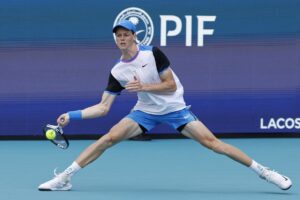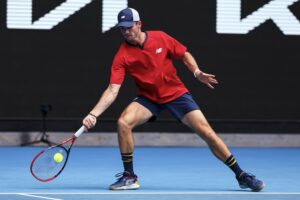Italy is, of course, the birthplace of the Renaissance – the remarkable rebirth of European culture, thought, and creativity in the late Middle Ages. Now, more than half a millennium later, it may also be home to a less historic but still significant sporting movement, namely the Tennaissance – the remarkable rise of Italian tennis, especially on the men’s side of the sport.
Is Tennaissance a Misnomer?
Now, before any art historians or cultural scholars, especially from Italy, rush to correct me, I will acknowledge that the term “Tennaissance” is something of a misnomer. “Renaissance” is actually a French word meaning “rebirth,” referring to the fact that Italian civilization and then wider European civilization was reborn or revived largely because of the rediscovery of Classical (Ancient Greek and Roman) books and artworks, many of which had only been preserved during Europe’s long dark ages by Arabic scholars and libraries.
The “Tennaissance,” which is obviously a pun on the word Renaissance, is not so much a rebirth of Italian men’s tennis as the birth or the first full flowering of Italian men’s tennis. Until this year, Italy had a relatively undistinguished history of men’s tennis, especially when set against what has always been a long national love affair with the sport. Only two Italian men had ever won Major Singles titles: Nicola Pietrangeli and Adriano Panatta. One of them (Pietrangeli) had actually been born in Tunisia and had the most extraordinary polyglot heritage, being of Italian, Russian, and Danish ancestry.
Indeed, a decade or more ago, it was Italian women who were flying the flag for the country’s tennis excellence. Francesca Schiavone became the first Italian woman ever to win a Major Singles title when she won the 2010 French Open. Five years later, Flavia Pennetta won the all-Italian 2015 US Open final when she defeated compatriot Roberta Vinci, who had defeated Serena Williams in the semifinal when the great American was on course to complete the Calendar Grand Slam (i.e. the actual Grand Slam of winning all four Majors in one year). And for good measure, Italy’s women won the Federation Cup, the precursor of the Billie Jean King Cup, a remarkable four times between 2006 and 2013.
So, when one writes about Italy’s “Tennaissance” now, it might be more accurate to call it the “Menaissance”, because nearly 20 years ago the country’s women were putting their male counterparts, who prior to this year had only ever won the Davis Cup once, to shame. Even today, Italy’s female tennis players, such as Martina Trevisan and Jasmine Paolini, continue to excel, particularly in team tennis, having finished runners-up to Canada in the final of the Billie Jean King Cup last year.
The Rise of Italian Men’s Tennis (and One Italian Man in Particular)
Now, however, it is undoubtedly male Italian tennis players who are at the forefront of the sport and their country’s consciousness of it, led by one man in particular, Jannik Sinner. This year, Sinner became Italy’s third male Major Singles champion when he won the Australian Open, in the process completing a remarkable journey that began with his breakthrough in Milan at the 2019 NextGen tournament, the end-of-season event for the best male players on the ATP Tour aged 21 or under, when he was only 18. And, of course, Sinner also spearheaded Italy to their second Davis Cup victory last November, which included the extraordinary feat of beating Novak Djokovic twice in one day, first in singles and then in doubles.
Unfortunately, Sinner will not be competing in Rome this year. He was part of the extraordinary “Bonfire of the Stars” at Madrid, whereby seemingly every highly ranked male player, other than Novak Djokovic, who wasn’t competing in the Spanish capital, succumbed to injury. Alongside Sinner, Carlos Alcaraz, Daniil Medvedev, and Jiri Lehecka, who reached the semifinals in Madrid, all limped out of the tournament. Even the eventual Madrid winner, Andrey Rublev, is a major doubt for Rome. After defeating Felix Auger-Aliassime in the Madrid final, he revealed that he had been suffering from a serious illness all week and would have to undergo hospital tests before traveling to Italy.
Sinner’s absence is a major blow for the organizers and fans in Rome, especially as there were genuine hopes that he could become the first Italian man to win the tournament in nearly half a century. The last Italian man to win in Rome was Adriano Panatta in his annus mirabilis of 1976 when he achieved the incredible hat-trick of winning the French Open (his only Major singles title), the Italian Open, and the Davis Cup.
However, just like nature, tennis abhors a vacuum, and Sinner’s absence gives other Italian players, especially other Italian men, an opportunity to emerge from his considerable shadow on home clay.
It is Time for Other Italian Men To Rise
In Sinner’s absence, the other obvious Italian contender is the next highest-ranked Italian man, Lorenzo Musetti, albeit at No. 29 in the world; he is a long way behind the No. 2-ranked Sinner. If anything, Musetti, a former world junior No. 1, may be even more naturally talented than Sinner, or at least it sometimes appears so to tennis purists because of his sumptuous one-handed backhand.
However, Musetti is yet to exhibit consistently the single-minded, indeed steely, fortitude that has become such a hallmark of Sinner’s recent performances, a situation that may not be completely unconnected to his having become a father for the first time recently at the relatively early age (especially in tennis terms) of 22.
Among the other Italian contenders in Rome is Matteo Arnaldi. He was the other hero of Italy’s Davis Cup win last autumn after he replaced the lackluster Musetti for the final against Australia, promptly winning the crucial first singles match against Alexei Popyrin.
There is also Luciano Darderi, who won the Córdoba Open in Argentina earlier this year (although Italian, Darderi was actually born in Argentina) as a qualifier. Perhaps most intriguing of all is Luca Nardi. Nardi, of course, is the man who stunned Novak Djokovic at Indian Wells earlier this year for the biggest win of his career. With his classical Italian good looks, he may be the most photogenic of all the young Italian men breaking through on the ATP Tour, if not yet the most successful.
Of course, that is without even mentioning Matteo Berrettini. Before Sinner’s emergence, Berrettini looked the most likely Italian man to win a Major, especially after he reached the Wimbledon men’s singles final in 2021, becoming the first Italian man to do so. Berrettini is still on the long road back from a serious injury. However, if he can ever recover his best form, especially the fearsome serve that earned him the nickname “Bullettini” (on the basis that he served bullets and not berets), he can be a Major contender again.
Finally, I would be remiss not to mention Sinner’s Davis Cup doubles partner, Lorenzo Sonego. He is a solid, hard-working professional who seems to maximize his talents. Sonego showed alongside Sinner at the Davis Cup last autumn that he is eminently capable of rising to the big occasion. If he can generate some momentum early on in Rome, he might just impress again this fortnight.
Tennis is an Individual Sport
However, even amid all the talk of a “Tennaissance,” it must always be remembered that tennis is an individual sport—indeed, the greatest individual sport in the world—and not a team sport. This means that success or otherwise is ultimately down to the individual, irrespective of the environment they find themselves in.
That is why it is so difficult for nations to sustain themselves at the top of tennis. Björn Borg’s domination of both Wimbledon and Roland Garros in the second half of the 1970s led to the emergence of several other great Swedish male tennis players, notably Mats Wilander and Stefan Edberg, but Swedish men’s tennis is now in a fairly parlous state, even in comparison with its Scandinavian neighbours.
Similarly, Andy Murray’s twin Wimbledon wins a decade ago (in 2013 and 2016) have not yet led to any major uplift in the number of British men competing at the top of the men’s game, notwithstanding the commendable efforts of Cam Norrie and Jack Draper. Most spectacularly of all, the USA, the greatest of all tennis nations for almost the entire 20th century, has not produced a male Major singles champion since Andy Roddick won the US Open in 2003.
It is the same situation now for Italian tennis, especially Italian men’s tennis. Sinner may have won a Major, but for all the talents of his contemporaries, especially Musetti, there is no guarantee that they can match him and challenge at the very top level of the sport.
On the other hand, Italian tennis fans and indeed Italians, in general, will be hoping that the recent excellence of Sinner, both as a Major singles champion and as his country’s key man in the Davis Cup, will encourage others like Musetti, Arnaldi, and Nardi to up their game, too, especially at their home Masters tournament. If they do, they will undoubtedly be warmly received and celebrated in one of the most tennis-mad nations in the world.
Main Photo Credit: Danielle Parhizkaran – USA TODAY Sports






